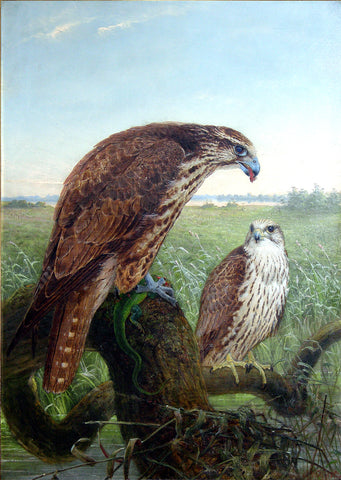
Joseph Wolf (German, 1820-1899), Saker Falcons
Joseph Wolf (German, 1820-1899)
Saker Falcons
Oil on canvas
Signed and dated lower right: J. Wolf 1864
Exhibited: Glenbow-Alberta Institute [now the Glenbow Museum], Calgary Canada,
“Birds of Prey”
Canvas size: 28 1/4 x 20 in.
Frame size: 35 1/2 x 27 1/2 in.
The national bird of Mongolia and Hungary, the saker falcon is a large, intimidating bird from central and eastern Asia; Wolf’s marvelous composition brilliantly captures the imposing grandeur of this magnificent animal while evoking an element of vulnerability that seems to foreshadow its current endangered status. Two falcons—carefully posed to present views of their rich brown primary feathers and barred, white underside—are perched on a tortuous tree trunk pressed to the front of the composition; behind them a deep, tranquil meadow fills the picture plane to suggest the great open grasslands in which these birds tend to roam. Separated from the meadow by an emergent body of water, the tree acts as a repoussoir, signifying depth to the viewer, yet also thrusting the large bird into our space. This interesting compositional choice, punctuated by the falcon’s piercing eye which meets and holds our gaze, is shrewdly made, for it conjures the ineffable mixture of fear and intimacy evoked through such a sublime encounter.
Across its vast territory, the saker falcon flies and hunts laterally, often preying on mid-sized diurnal rodents; the reptile trapped under the raptor’s talons in Wolf’s painting is thus somewhat unusual, but in fact this too serves marvelously to charge the composition. Highlighting the vast array of greens woven throughout the work, the long reptile unifies the scene and mediates a subtle but striking harmony, befitting the intimidating yet calm presence of the two falcons depicted. The emerald green of the reptile’s scales is also complementary to the rich, true browns that characterize the saker falcon’s mottled plumage, and this relationship ignites a vibrancy in each of the colors; indeed, with its rigorously rendered surface creating physical texture, the rich coloring of the falcon’s broad wings and tail seems to shimmer and sparkle, as though ruffling in the wind gusting across the plane. With the inclusion of the mossy tree and mounding vegetation, the browns and greens continue to intermingle on a vertical axis that stabilizes the composition while adding to the sense of drama and immediacy captured in the scene.
JOSEPH WOLF (GERMAN, 1820-1899)
Sir Edwin Landseer described Joseph Wolf as “...without exception the best all-round animal painter who ever lived.” Born and educated in Prussia, Wolf left home at the age of 16 and apprenticed himself to the lithographic firm of Gebruder Becker in Coblenz, where he first met his future patron Hermann Schlegel, then the assistant keeper at the museum in Leyden and a prolific author of ornithological works. After brief spells in Frankfurt and Darmstadt, Wolf went to Holland and settled in Leyden in 1840; he was soon at work on the illustrations for Traite de Fauconnerie by Schlegel and Wulverhorst. Working on this book on falconry, Wolf became an expert at portraying birds of prey, a flawless skill of representation that is in full evidence in his watercolors.
After developing contact with John Gould, Wolf established himself in London in 1848, where he exhibited at the Royal Academy, met Edwin Landseer and other animal artists, and won the patronage of discerning collectors like the Duke of Argyll and Lord Derby. He quickly became the foremost animal illustrator in Britain. Wolf had a long and productive relationship with Gould, contributing plates to The Birds of Asia and The Birds of Great Britain, and Gould became a frequent visitor to Wolf’s studio. The rapidity of the growth of his reputation was due, according to his biographer A.H. Palmer, to his power “of revivifying a dried skin and not merely revivifying, but showing the most characteristic and beautiful attitude and expression of the living bird or animal.” However, Wolf did not wish to be categorized as a scientific illustrator, preferring to create complete and naturalistic compositions which conveyed a sense of drama and mystery. Rather than show his subjects isolated from their environment, he integrated them into a natural setting and portrayed them involved in dramatic action. This combination of animation and beauty characterizes Wolf’s watercolors.
In 1852, the British Zoological Society commissioned Wolf to complete several watercolors for its Zoological Sketches published in parts between 1856 and 1867. P.L. Sclater, the secretary of the society, noted in the publication’s preface, “the Council was fortunate enough to secure the services of Mr Joseph Wolf, who may be fairly said to stand alone in intimate knowledge of the habits and forms of Mammals and Birds.” By this stage in his career, Wolf’s works were in considerable demand both in their own right and as illustrations to books and journals. From 1859 to 1869 he was the regular artist for Ibis, the journal of the Zoological Society, and his work was also reproduced in the Illustrated London News, Once a Week, The Leisure Hour, The Sunday at Home, and The Graphic. Unfortunately, during the 1870s, Wolf was increasingly hindered by the onset of chronic rheumatism, which gradually curtailed his work, but he lived on into his eightieth year and died in London surrounded by his pet birds and held in high popular esteem. More than three-quarters of a century later his plates are regarded as among the finest productions of the great period of the illustrated book, while his oil paintings, watercolors and drawings are prized by museums and collectors alike.
or by email at loricohen@aradergalleries.
We Also Recommend





